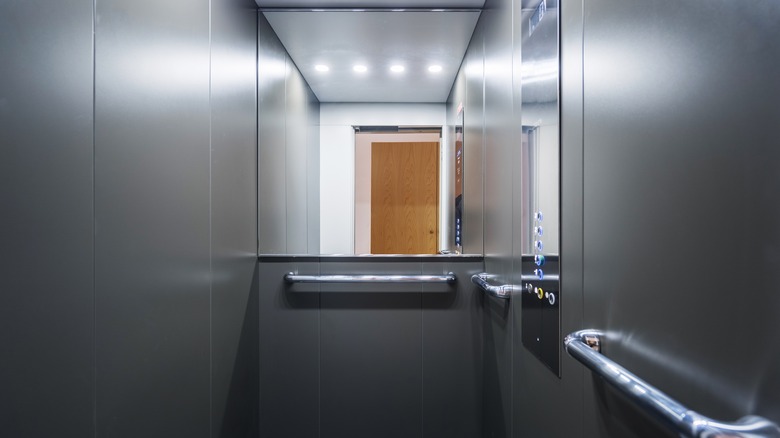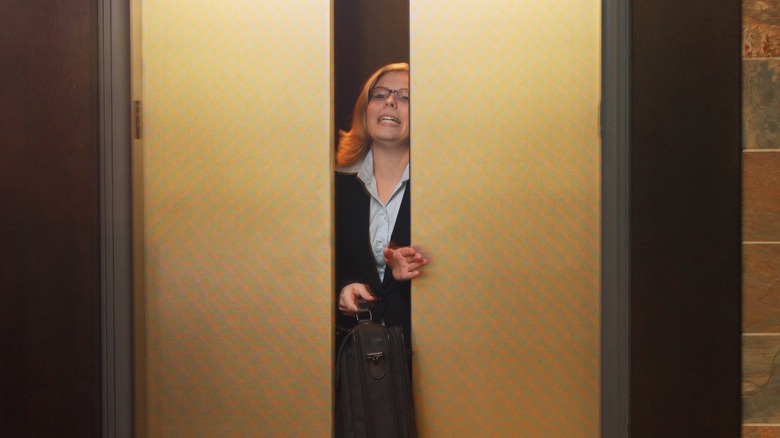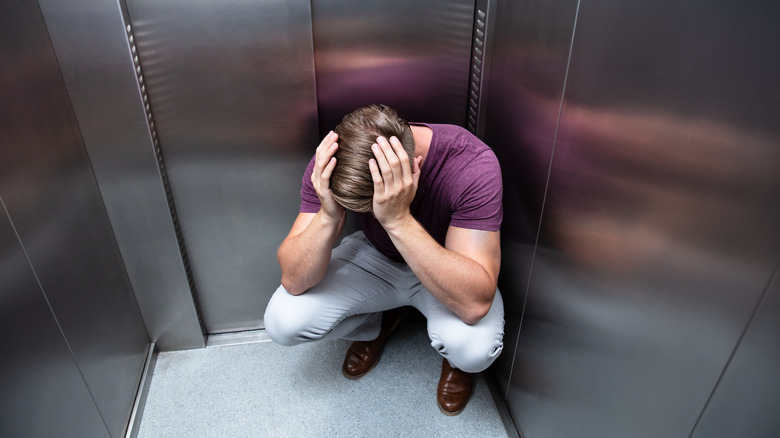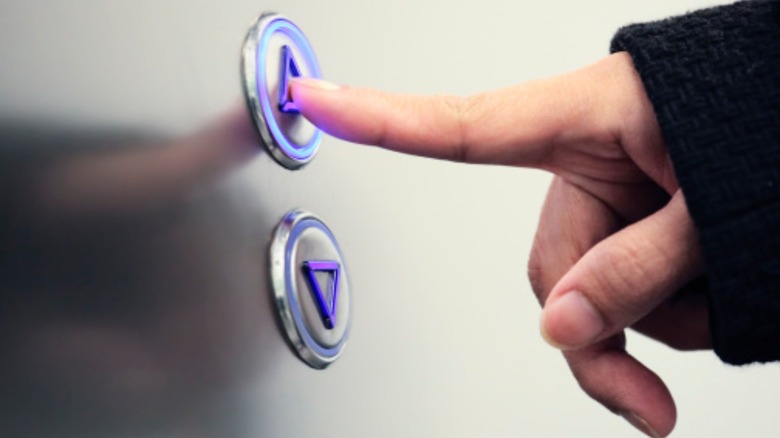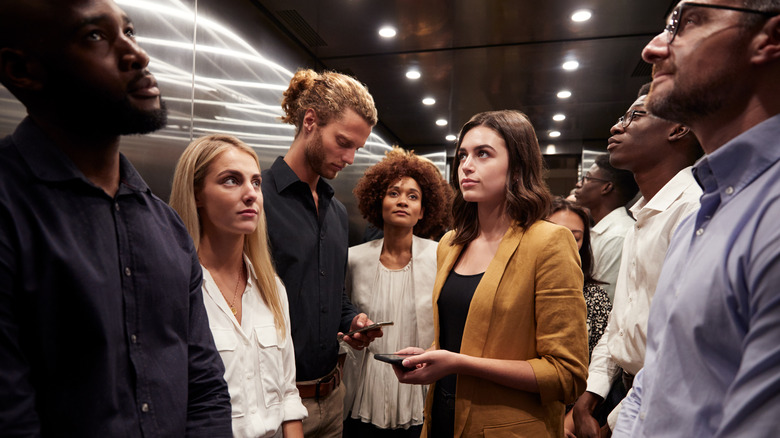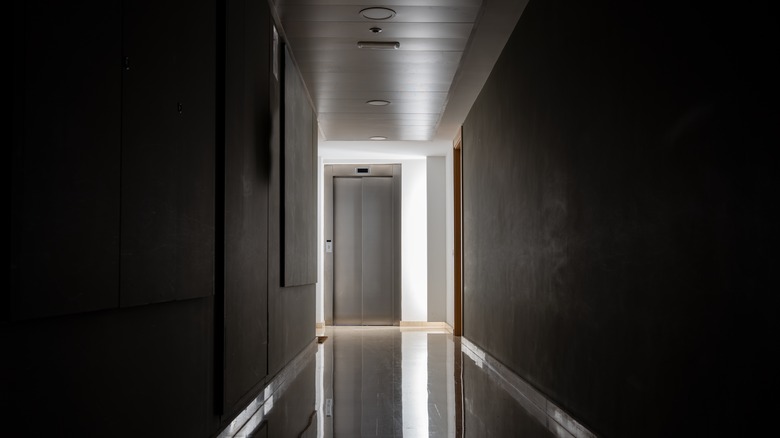Why People Hate Riding In Elevators According To Science
For many people, elevators are a part of everyday life. According to National Elevator Industry Inc., there are over 1 million elevators in the United States. Every day, 325 million elevator rides travel an estimated 1.36 billion miles a year combined (per Connections Elevator). TK Elevators claims that more than 245 million Americans use an elevator daily.
For many people, whether they're traveling up to an office or to an apartment in a high rise building, riding in an elevator is such a routine and anonymous part of the day that they barely remember it. However, plenty of others find using these machines to be a hugely stressful experience for a variety of personal reasons. Recent studies have uncovered various scientific explanations as to why elevators can be unpleasant, from the psychological responses of travelers to design issues. Here's the lowdown.
A claustrophobic experience
Like medical terms such as obsessive-compulsive disorder (OCD), the idea of claustrophobia is now such a touchstone in Western culture that, unlike many other phobias, most people know what the phrase means. They use it in casual conversation when they're in a confined space, or may even use it metaphorically to describe their social interactions.
But claustrophobia is a real anxiety disorder — a fear of being confined in a small place. Those living with it can experience a range of adverse reactions, including an increased heart rate, breathing issues, shaking, and panic attacks. Elevators, which are typically windowless and often only a few feet wide, can be a nightmare for the estimated 12% of people who experience claustrophobia (per StatPearls). With elevator use such a regular part of daily life for millions of Americans, this can present a real problem. So much so that some therapists now offer specialized elevator phobia therapy to help people with the disorder develop techniques and tools to use elevators calmly and with minimal stress.
Traumatic experiences
Therapist Dr. Fredric Neumann of the Anxiety and Phobia Treatment Center at White Plains Hospital Center told The New York Times that in most cases, claustrophobia seems to arise with no explanation. "There is no underlying trauma, just as people develop driving phobias without ever having been in a car accident," he said. Still a smaller number people develop phobias, and especially elevator phobia, as a result of traumatic events.
Although elevators are considered a safe form of travel, occasionally power cuts and other issues can make an elevator malfunction. Passengers can become trapped for long periods of time, which can be traumatic. As most therapists will tell those with claustrophobia, it is advisable to remain calm in such scenarios and wait for the elevator to return to service.
It is incredibly rare that passengers experience anything as catastrophic as an elevator free fall, which would require multiple steel cables supporting the compartment to snap. They are specially designed to hold far more than the maximum weight that could fit in an elevator, and passengers are incredibly unlikely to die in an elevator accident, but that doesn't stop many people worrying about it. Some have reported a phobia of being trapped in an elevator door, as depicted in the horror movie "Final Destination." Though once again, such disasters are incredibly rare, and experts believe that their depictions in media could potentially trigger elevator phobia in viewers.
Elevator button systems are frustrating
On the surface, the system of buttons by which passengers operate an elevator is incredibly simple. You push one for the elevator, which also indicates your direction of travel. The elevator arrives on your floor, and you step inside, where you select from a bank of numbered floor buttons.
But with many elevators things aren't quite that simple. As Verge Science found when they explored the subject in 2019, some elevators that also employ security card verification for passengers are inconsistent with their timings. Notably, the buttons are inoperable during busy periods if a person attempts to swipe in during a five-second window after the person before them, preventing them from selecting their floor. Such design flaws can make operation awkward and stressful, particularly during peak times such as the start and end of the working day. As can so-called "placebo," buttons such as those that read "close door," which often don't affect the movement of the elevator in the way passengers think and are intended primarily for emergency personnel.
Using one means close proximity with others
Such quirks compound another issue that many passengers have with elevators: Forced proximity with other people. In many elevator journeys, passengers are forced to share a confined space with strangers, colleagues, or neighbors they barely know, which violates many of the personal space principles that exist in the modern world. It also may heighten anxiety disorders including claustrophobia and agoraphobia.
As a result, psychologists claim that we have collectively developed a code of behavior around elevator riding that goes way back to their first widespread use at the start of the 20th century. Lee Gray — associate dean at the University of North Carolina whose research interests include the history of elevators — explained to NPR that how you stand in an elevator when alone, perhaps in the center, is different to how you would with three other passengers, when you would each take a corner. Similarly, the vast majority of passengers face the door, waiting for it to open, rather than face the back or those around them directly.
For some, such as those with autism, unwritten rules may be difficult to master, Gray said. Elsewhere studies have shown that positions in which people stand in an elevator are often drawn along age and gender lines. Unspoken power dynamics are at play even when people are just trying to get from one floor to another.
An elevator is a liminal space
Finally, it can be argued that elevators feed into a common feeling of unease that is only just beginning to come to light in the modern world — that which many feel toward liminal spaces. Liminality is an anthropological concept concerning the feeling we get when experiencing transitional states. The word derives from the Latin word "līmen," which means doorway or threshold. These states can be brought about by architecture, such as in corridors and stairwells, as well as transport.
In recent years, liminal spaces — which include elevators — have attracted a great deal of attention on the internet. Users of various apps and forums have established a meme genre that involves sharing images of familiar but uncomfortable liminal spaces to elicit what many claim are unnerving emotional responses. Some find such areas eerie or disturbing, a phenomenon that suggests an underlying unease about things like elevators, even as we use them as part of our everyday lives.
If you or someone you know needs help with mental health, please contact the Crisis Text Line by texting HOME to 741741, call the National Alliance on Mental Illness helpline at 1-800-950-NAMI (6264), or visit the National Institute of Mental Health website.
